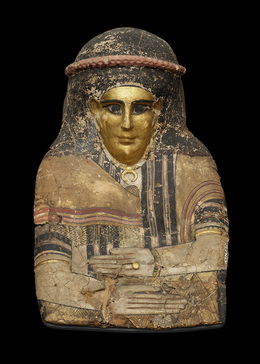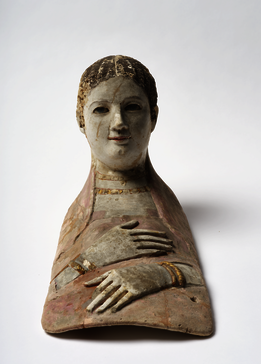White marble has generally been considered a typical image of antiquity. However, the lack of colour has no relation to ancient aesthetics. In fact, antiquity cultivated a veritable wealth of colours, but after centuries of deterioration, very little paint remains on the artefacts giving rise to the mistaken notion of white marble as a classical ideal.
Yet the knowledge that ancient art was polychrome does not mark the end of polychromy research. On the contrary: Now research of ancient polychromy can continue acquiring a more comprehensive and detailed knowledge of how the ancient world was coloured and why.
This website is dedicated to the research on the use of colour in the ancient Mediterranean world carried out at the Ny Carlsberg Glyptotek. This research is highly interdisciplinary including scholars in archaeology, philology, conservation science, geology, geochemistry, chemistry, and physics.
Current research: Mummy Busts and Gilded Mummy Masks from Roman Egypt
Currently, our research focuses on mummy masks and mummy busts from Roman Egypt. These mummy decorations, all of which represent a special blend of Egyptian and Greco-Roman culture, were part of the extensive rituals and measures that the Egyptians practised to preserve the body after death. The polychromy of these ancient artworks is studied using multispectral imaging and various analytical techniques. The aim is to comprehensively investigate and document these mesmerizing objects that have previously not been studied.
“Decorated Bodies for the Eternal Life: Investigations of the Polychromy of funerary art from Roman Egypt” (2023-2024). This project is generously funded by Kirsten and Freddy Johansens Foundation. In this project, an extensive investigation is carried out on 14 Egyptian mummy decorations (primarily in the form of painted plaster busts) from the Roman period (1st to the 3rd century CE). The aim of the project is to establish the methods and materials used for their construction as well as their relation to the polychromy of Roman Imperial portraiture.
“Gilded mummy masks from Roman Egypt” (2022-2024). As a part of the ArcHives project, funded by Carlsbergfondet Semper Ardens (CF18‑1110), five gilded mummy masks in the collections of the Ny Carlsberg Glyptotek are studied to identify the various materials used for their creation, including pigments, gilding, plaster, textiles, and adhesives. The masks date to the period from the 1st century BCE to the 3rd century CE. The timelessness presented by these gilded mummy masks reflects Egypt’s profoundly conservative society, where the elite culture prioritised the continuity of the past.
Images Anders Sune Berg Ⓒ the Ny Carlsberg Glyptotek.







